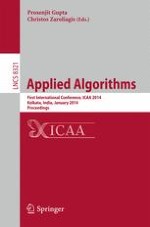This book constitutes the refereed proceedings of the First International Conference on Applied Algorithms, ICAA 2014, held in Kolkata, India, in January 2014. ICAA is a new conference series with a mission to provide a quality forum for researchers working in applied algorithms. Papers presenting original contributions related to the design, analysis, implementation and experimental evaluation of efficient algorithms and data structures for problems with relevant real-world applications were sought, ideally bridging the gap between academia and industry. The 21 revised full papers presented together with 7 short papers were carefully reviewed and selected from 122 submissions.
